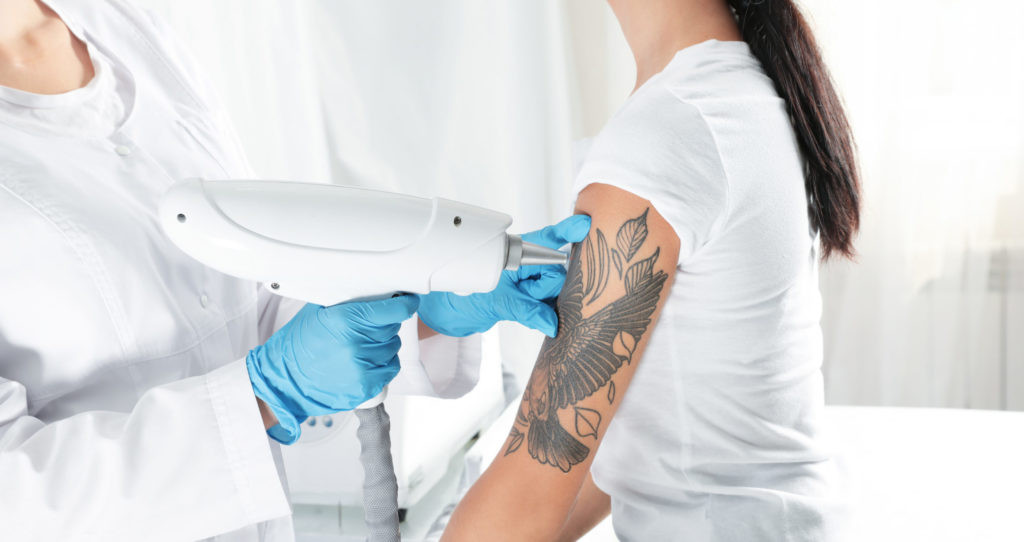Thinking about getting a new tattoo after laser removal? Absolutely! At tattooat.com, we’re here to guide you through the process, ensuring you can confidently express yourself with fresh ink on a clean canvas. Laser tattoo removal offers a fantastic opportunity to correct past tattoo regrets and open up a world of new artistic possibilities. Let’s explore the best practices for timing, potential risks, and how to ensure optimal results for your next tattoo masterpiece. Ready to learn more about tattoo revision, ink correction, and skin preparation?
1. Is It Possible to Get a Tattoo After Laser Removal?
Yes, getting a tattoo after laser tattoo removal is generally possible and a common practice. However, patience is key. After laser removal, your skin requires time to heal fully before it’s ready for new ink. The general recommendation is to wait 6-8 weeks after completing your last laser session. This waiting period allows the skin to fully recover and minimizes potential complications, ensuring the best possible canvas for your new tattoo.
- Waiting allows the skin to regenerate.
- It also reduces the risk of complications.
- Proper healing improves the new tattoo’s appearance.
2. What Does Laser Tattoo Removal Involve?
Laser tattoo removal is a sophisticated process that breaks down tattoo ink using concentrated light beams. This process works by:
-
Targeting the Ink: The laser emits light energy that penetrates the skin and is absorbed by the tattoo ink particles.
-
Breaking Down the Ink: The ink particles shatter into smaller fragments due to the heat and energy.
-
Natural Elimination: The body then eliminates these smaller ink fragments through the lymphatic system.
 Laser tattoo removal process visualized
Laser tattoo removal process visualized
The effectiveness of laser tattoo removal depends on factors such as the tattoo’s size, the colors used, ink density, and the type of ink. Multiple sessions are usually required to achieve complete or significant fading of the tattoo.
3. How Long Should I Wait Before Getting a New Tattoo?
Waiting the appropriate amount of time is essential to ensure your skin is fully healed and ready for a new tattoo.
- Typical Waiting Period: Generally, wait 6-8 weeks after your last laser tattoo removal session.
- Factors Affecting Healing Time: Healing can vary based on individual skin types, the extent of the laser treatment, and how well you care for the treated area.
- Complete Restoration: It’s often best to wait longer than the standard 6-8 weeks to ensure complete skin restoration, reducing the risk of complications and ensuring the new tattoo looks its best.
4. What Risks Are Involved in Tattooing Over Previously Treated Skin?
While re-tattooing is generally safe, there are potential risks to be aware of:
- Scar Tissue: Although uncommon, laser tattoo removal can sometimes result in minor scar tissue. Scar tissue can interfere with the new tattoo ink settling evenly, potentially affecting the design’s clarity.
- Uneven Ink Distribution: Scar tissue can cause uneven ink distribution, leading to blurred or inconsistent lines in the new tattoo.
- Skin Sensitivity: The treated skin might be more sensitive, making the tattooing process more uncomfortable.
A consultation with both your laser removal specialist and tattoo artist can help identify and mitigate these risks.
5. How Does Scar Tissue Affect New Tattoos?
Scar tissue can present several challenges when tattooing over previously treated skin:
-
Ink Absorption: Scar tissue can affect how the skin absorbs ink, leading to inconsistent color saturation.
-
Design Definition: Scar tissue can distort the design, making it less sharp and defined.
-
Texture Differences: The texture of scar tissue differs from that of healthy skin, which can affect the overall appearance and feel of the tattoo.
Aspect Healthy Skin Scar Tissue Ink Absorption Even and Consistent Potentially Uneven Design Definition Sharp and Clear May Appear Distorted or Blurred Texture Smooth and Uniform Raised, Bumpy, or Uneven Comparison of healthy skin vs. scar tissue for tattoo application.
6. What About Laser Hair Removal Before Getting a Tattoo?
Yes, laser hair removal can actually enhance the final outcome of your tattoo. Smoother, hair-free skin can make the tattoo look even better. Laser hair removal works similarly to tattoo removal by using light and heat energy but targets hair follicles instead of ink. You should wait about 6 weeks after your last laser hair removal session before getting a tattoo.
7. How Can I Minimize Risks and Ensure the Best Results?
To minimize risks and achieve the best possible results when getting a tattoo after laser removal:
- Consultation is Key: Consult with your laser removal specialist and tattoo artist. They can assess your skin and provide tailored advice.
- Choose an Experienced Artist: An experienced tattoo artist can adapt their technique to work with skin that has undergone laser treatment, minimizing potential issues.
- Follow Aftercare Instructions: Strict adherence to aftercare instructions is crucial for proper healing and preventing complications.
8. What Aftercare Steps Should I Follow?
Proper aftercare is vital for ensuring your skin heals well and your new tattoo looks its best.
-
Keep the Area Clean: Gently wash the tattooed area with mild, fragrance-free soap and water.
-
Moisturize Regularly: Apply a thin layer of tattoo-friendly moisturizer to keep the skin hydrated.
-
Avoid Sun Exposure: Protect the tattooed area from direct sunlight by wearing loose clothing or using a high-SPF sunscreen.
-
Stay Hydrated: Drinking plenty of water helps keep your skin hydrated from the inside out.
-
Avoid Picking or Scratching: Refrain from picking or scratching the tattooed area to prevent infection and scarring.
Aftercare Step Description Cleaning Wash gently with mild soap and water. Moisturizing Apply tattoo-friendly moisturizer. Sun Protection Avoid direct sunlight or use sunscreen. Hydration Drink plenty of water. Avoid Irritation Do not pick or scratch. Essential aftercare steps for optimal tattoo healing.
9. What are the Latest Advancements in Laser Tattoo Removal?
Advancements in laser technology have significantly improved the tattoo removal process.
- Picoway Laser: Picoway laser tattoo removal is one of the most advanced methods available. It uses ultra-short pulses to shatter ink particles more effectively, often requiring fewer sessions than traditional lasers.
- Reduced Treatment Time: Picoway can remove a tattoo in half the time compared to traditional laser methods.
- Enhanced Precision: Advanced lasers offer enhanced precision, reducing the risk of damage to surrounding skin.
10. How Does Skin Condition Affect Tattooing After Laser Removal?
The condition of your skin after laser removal plays a crucial role in the outcome of your new tattoo. Factors such as skin elasticity, hydration levels, and overall health can impact ink absorption and healing. Ensuring your skin is in optimal condition through proper skincare and hydration can significantly improve the results.
11. Can I Get a Cover-Up Tattoo After Laser Removal?
Yes, a cover-up tattoo is a great option after laser tattoo removal. Laser removal can lighten the old tattoo enough to allow for a fresh, new design to take its place. A skilled tattoo artist can create a beautiful cover-up that completely transforms the area.
- Lightening the Old Tattoo: Laser removal fades the previous tattoo, making it easier to cover.
- New Design Options: More design options become available as the old tattoo becomes less prominent.
- Artistic Transformation: A skilled artist can create a stunning transformation with a well-executed cover-up.
12. What Tattoo Styles Work Best After Laser Removal?
Certain tattoo styles work better than others on skin that has undergone laser tattoo removal. Bold designs, vibrant colors, and styles that incorporate shading can help camouflage any residual scarring or unevenness.
- Bold Designs: Styles with strong lines and solid colors are effective for cover-ups.
- Vibrant Colors: Bright colors can draw attention away from any imperfections in the skin.
- Shading: Shading techniques can add depth and dimension, helping to conceal any unevenness.
13. What Role Does Tattoo Ink Play in Laser Removal and Re-tattooing?
The type of ink used in your original tattoo can affect both the laser removal process and the outcome of your new tattoo. Some inks are easier to remove with lasers than others, and certain inks may react differently to the tattooing process after laser treatment.
- Ink Composition: Different ink types respond differently to laser treatment.
- Color Considerations: Darker inks are generally easier to remove than lighter colors.
- Potential Reactions: Certain inks may react differently to the skin after laser treatment, affecting the new tattoo.
14. How Can I Find the Right Tattoo Artist for the Job?
Finding the right tattoo artist is crucial for achieving the best results, especially when tattooing over previously treated skin. Look for an artist with experience in cover-up tattoos and working with skin that has undergone laser treatment.
- Research and Reviews: Check online reviews and ask for recommendations.
- Portfolio Review: Examine the artist’s portfolio to assess their skill and style.
- Consultation: Schedule a consultation to discuss your design ideas and assess the artist’s suitability.
15. What Are the Long-Term Effects of Re-Tattooing After Laser Removal?
While re-tattooing is generally safe, it’s important to consider the potential long-term effects on your skin. Repeated tattooing and laser removal can cause cumulative damage, so it’s essential to take good care of your skin and allow sufficient healing time between procedures.
- Cumulative Damage: Repeated procedures can cause long-term skin damage.
- Skin Sensitivity: The skin may become more sensitive over time.
- Proper Care: Adequate skincare and healing time can mitigate potential long-term effects.
16. Can Certain Skin Conditions Affect My Ability to Get a Tattoo After Laser Removal?
Yes, certain skin conditions can affect your ability to get a tattoo after laser removal. Conditions such as eczema, psoriasis, and dermatitis can increase the risk of complications and affect the healing process.
- Eczema and Psoriasis: These conditions can cause inflammation and irritation, affecting ink absorption and healing.
- Dermatitis: This condition can make the skin more sensitive and prone to infection.
- Consultation: Consult with a dermatologist to assess your skin condition and determine the best course of action.
17. How Important is a Patch Test Before Getting a New Tattoo?
A patch test is highly recommended before getting a new tattoo, especially after laser removal. This test helps determine if you have any allergic reactions to the tattoo ink.
- Allergy Detection: A patch test can identify potential allergic reactions to tattoo ink.
- Skin Sensitivity: It can also assess how your skin reacts to the tattooing process.
- Prevent Complications: A patch test can prevent complications and ensure a smoother tattooing experience.
18. What if I Experience Complications After Getting a Tattoo Post-Laser Removal?
If you experience any complications after getting a tattoo post-laser removal, it’s important to seek professional medical advice immediately. Signs of complications include:
-
Infection: Redness, swelling, pain, or pus.
-
Allergic Reaction: Itching, rash, or hives.
-
Scarring: Excessive scar tissue formation.
Complication Symptoms Action Infection Redness, swelling, pain, pus Seek medical attention immediately. Allergic Reaction Itching, rash, hives Consult a doctor or dermatologist. Scarring Excessive scar tissue formation Discuss treatment options with a dermatologist or tattoo artist. Common complications and necessary actions after getting a tattoo.
19. What Are Some Common Misconceptions About Getting a Tattoo After Laser Removal?
There are several misconceptions about getting a tattoo after laser removal that it’s important to clarify:
- Complete Removal Required: It’s not always necessary to completely remove the old tattoo before getting a new one.
- Same Healing Time: Healing time may vary depending on individual factors.
- Any Artist Can Do It: Not all tattoo artists have experience working with skin that has undergone laser treatment.
20. What Resources Does tattooat.com Offer for Tattoo Enthusiasts?
tattooat.com offers a wealth of resources for tattoo enthusiasts, including:
- Extensive Design Library: A vast collection of tattoo designs across various themes and styles.
- Artist Directory: A curated list of talented tattoo artists and reputable studios across the USA.
- Detailed Guides: Comprehensive articles on tattoo processes, preparation, and aftercare.
- Expert Advice: Answers to frequently asked questions about tattoos, including pain management and safety.
- Inspiration and Trends: Updates on the latest tattoo styles, trends, and cultural insights.
At tattooat.com, we understand the importance of informed decisions and safe practices. Whether you’re exploring new designs, seeking a skilled artist, or understanding the nuances of tattoo aftercare, we’re here to support you every step of the way.
Ready to explore the world of tattoos? Discover unique designs, find talented artists, and gain essential knowledge at tattooat.com. Start your tattoo journey with confidence today!
Address: 1825 SW Broadway, Portland, OR 97201, United States
Phone: +1 (503) 725-3000
Website: tattooat.com

